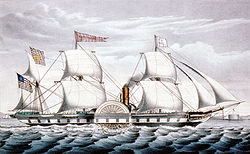Washington (ship, 1847)
|
||||||||||||||||||
|
||||||||||||||||||
|
||||||||||||||||||
|
||||||||||||||||||
The Washington was a paddle steamer of the US-American shipping company Ocean Steam Navigation Company (OSNC), which was built in 1846 and opened the first regular mail steamship line between North America and the European continent on the route between New York and Bremerhaven .
construction
The Washington was laid down on September 7, 1846 on behalf of the Ocean Steam Navigation Company, founded with US and German capital, at Westervelt & MacKay in New York and was launched on January 30, 1847. With a length of 75 meters, a width of 12 meters (without the two side wheel arches) and a displacement of 2,632 tons , it was considered one of the largest ships of its time. The construction cost 250,000 US dollars .
The ship's two steam engines with 1,000 hp each came from Stillman, Allen & Co. and provided a speed of 15 knots , about 28 kilometers per hour , via two side paddle wheels .
The Washington carried a total of 182 passengers - 112 in first and 70 in second class. There was a salon for each class, as well as a common smoking salon, a bathroom and a barber's room. Unlike z. As the contemporary ships of the British Cunard Line ordered that Washington does not have favorable tween decks -Quartiere for emigrants , but was focused on freight and wealthy passengers: a ride in first class cost 120 US dollars, a ride in the second class $ 60.
commitment
On June 2, 1847, the Washington ran under Captain Frederick Hewitt from New York for her first Atlantic crossing with 127 passengers on board. She reached the Old Harbor on June 19, where she was received with a salute . The originally planned voyage duration of 14 days could not be achieved because the departure had already been delayed by 20 hours and the ship was stuck in Southampton for two days due to an engine failure . The return trip was delayed by two weeks due to repairs, so that the Washington only arrived in New York on July 30th.
It turned out that the construction of the ship, but above all its machinery, had significant weaknesses, which resulted in frequent repairs and, together with high coal consumption, increased operating costs considerably. It also turned out that the exclusion of the transport of emigrants was a wrong decision, as this provided steady income in the Atlantic shipping of the 19th century, which at that time could not be achieved with the transport of cabin passengers, mail and freight.

From 1849 onwards, the Ocean Steam Navigation Company succeeded in ensuring a largely regular timetable with the Washington and her sister ship Hermann, built in 1848 , whereby the journey times of 16 to 18 days were still well above the targeted 14 days. A stop at Cowes had also been made on the route to pick up additional mail to and from England. In the following years, passenger numbers and freight volumes also increased, so that the OSNC made profits from 1853 and was able to pay dividends to its shareholders .
After the United States did not renew the company's state postal contract in 1856, the shareholders decided to liquidate the Ocean Steam Navigation Company , as an operation without subsidies appeared unprofitable. On July 12, 1857 , the Washington began her last voyage from Bremerhaven. After arriving in New York, she was sold to California , where she brought prospectors to the West Coast for a number of years. In 1863 the ship was scrapped.
literature
- Herbert Black Forest : The Great Bremen Lexicon . 2nd, updated, revised and expanded edition. Edition Temmen, Bremen 2003, ISBN 3-86108-693-X .
- Rolf Böttcher: Arrival of the paddle steamer "Washington" in Bremerhaven 1847 . Verlag für neue Wissenschaft GmbH, Bremerhaven 1997, ISBN 3-89429-890-1
Web links
- The OSNC on the website The Ships List (English)
